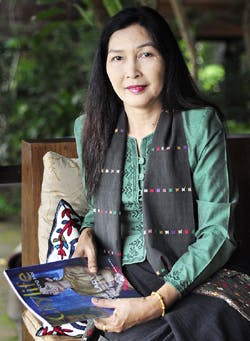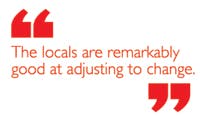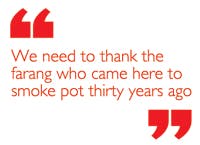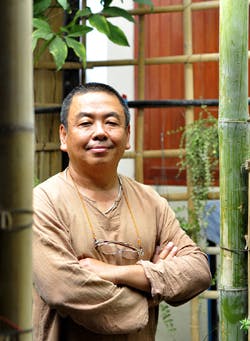
An elegantly svelte lady, demurely dressed in a traditional sarong, Patcharee Arjhan, owner of Baantawan Pai Guesthouse, sat down to talk Pai to me in her wooden sala by the Pai River. Former president and current Planning and Projects Director of the Tourism Association of Pai, few people understand the delicate balance of Pai’s growth and development like she does.
Having spent her career working for the Community Development Department at Chiang Mai’s city hall, Patcharee woke up one day and realised that her life was her work and that she had gone years without indulging herself or fulfilling her own desires. “I had no freedom; my work responsibilities took up all of my time,” she said of her life’s greatest decision over a decade ago. “So, I left my job and decided to move to America to get rich before returning to Thailand for my retirement.”
Just before she left, however, her brother told her about a one rai piece of land by the Pai River that was for sale. Tempted, she went to take a look and immediately fell in love. “I decided to take some time off, build a simple house and relax a bit. I never realised that it would turn into a business. But farang would come and ask us all the time if we had room and so we began to build a few basic bungalows. Even then, I didn’t think this was going to be a long-term venture. I thought it would be good to practice my English and make some friends before heading to the States.”
Occupancy rates, even after adding on more rooms, were always maxed out and by 1999 Baantawan became a word-of-mouth ‘it’ place amongst many backpackers who would come to cook in the open kitchen, dine in large groups by the river each night and cajole Patcharee to drive them up into the mountains for all-night jungle parties.

Patcharee, along with many other residents and business owners, began to turn into an activist after that great flood. They began to see that they had a responsibility towards Pai’s future and realised that they needed to communicate closer with the government authorities and work to find a balance between economy and growth on one hand and culture and environment on the other.
Patcharee was fortunate in that her brother came to the rescue and together they rebuilt their guesthouse. Gleaming teak verandahs, lush tropical gardens and decked-out, spacious accommodations are still pulling in guests at her resort. Patcharee, however, was already firmly entrenched in her new-found position as a member of the Tourism Association.
“There are so many issues we are working on,” she continued. “For instance, I know that people have been angry to see that Pai installed traffic lights three years ago; even many locals. But the fact is that many farang rent motorbikes for 100 baht a day and don’t know how to ride them. There were accidents all the time. So we had to lobby the authorities. We are also working on talks to prep Pai for the 2015 Asean Economic Community; it is only a four hour drive from here to Burma’s Huay Toon Noon border. Pai should become an important part of the route to Burma. Did you know that the distance from Mae Hong Son to Burma’s capital, Naypyidaw, is not much more than 100 kilometres, as the crow flies?”
“We need to thank the farang who came here to smoke pot thirty years ago,” smiles Patcharee. “They came here to get high, to trek and to raft. It was all word of mouth and it was a beginning, and even though the locals thought they were weird, the relationships between locals and visitors have always been harmonious. The locals are remarkably good at adjusting to change. Then about ten fifteen years ago, pioneered by Chart from Bebop Bar and other like-minded Thais, Pai began to attract musicians and artists. They came and brought culture with them. More and more backpackers arrived. Restaurants, bars, shops and internet cafes began to open up, people used social media, writing blogs and posting things online. The biggest change, however, happened post-tsunami.”
Patcharee talked about how the winters following the tsunami brought an onslaught of Thai tourists. “Pai exploded,” she recalled. “In one year, 100 hotels and guesthouses opened. Two very famous Thai movies – Pai in Love and Rak Jung -turned Pai into an overnight sensation. We weren’t ready; we didn’t have enough clean rooms, toilets, petrol stations…Pai went into shock. People were sleeping in tents and in temples. Investors, many of them movie stars and celebrities, came from Bangkok and bought up vast swathes of land, dumped hundreds of millions of baht into expensive resorts. There is no way to know, but we estimate that there was one year where there were 10,000 beds to rent in Pai. Of course, I am talking tents and the hundreds of villagers and townspeople who left their houses for a few months, turning them into beds and breakfasts, not just official hotel rooms.”

“The media’s darling became its laughing stock and we were devastated,” said Patcharee. “The fact is these Bangkok visitors come to Pai for one night. They drive from Chiang Mai, check into their expensive resorts, spend the evening getting drunk or taking in the Pai vibe, then leave the next morning – having taken one hundred photos! They are not into culture, they don’t do anything, they don’t understand or get us at all. You need to BE Pai, spend time looking at a flower, sit by a waterfall, walk in the jungle… that is Pai. When things did not go as smoothly as they expected – long queues, traffic jams – they were disillusioned.”
Although Pai’s residents galvanised themselves to fix all the problems caused by over-congestion in that one year, the damage was done and Pai still suffers from a bad rap in Thailand.

“Our fantasy is that we remain a tourist town while resisting certain types of tourism-related developments – golf courses, karaoke bars, shopping malls. We think we are about the right size now, our growth has hit a ceiling. In the low season we have farang, in the high season we have Thais. Some of the newer buildings aimed at Thai tourist photo ops are pretty ugly, but what can we do, we are a free country. While we have managed to halt some construction and force others to rethink their designs, we don’t have much power.”
Patcharee is confident that the Pai she fell in love with still remains, she is also conscious of the challenges ahead for this previously tiny hamlet-in-the-hills, but believes that there are no enough people truly invested in Pai’s future working towards it.

“Pai has around 30-40,000 residents, we are a pretty close-knit community, but yet, there are many people who come here for privacy. You can live here for ten years and not have met someone who lives nearby,” he says over a refreshing Kombucha (a local drink made from fermented green tea, said to be a cure-all for hangovers, an energiser and immune booster). “What is great about our community is the variety and acceptance of difference. Farang and Thai people who come from elsewhere bring culture and arts while the local culture is strong enough to withstand any invasion. It makes for a very interesting mix. My life is very simple. I go to the market every morning on my motorbike to get fresh ingredients and our mainly-farang clients keep us busy via word of mouth. After dinner I go home to relax with my family. Like Ubud, Vangvieng, Goa, people who recognise a good thing simply tell other likeminded people about it. We don’t need a PR machine to promote us, we have recommendations from those who know. People who come here are here to travel and make friends. They tend to be very nice. My secret love for this place is that brand names mean nothing here. It is true freedom.”